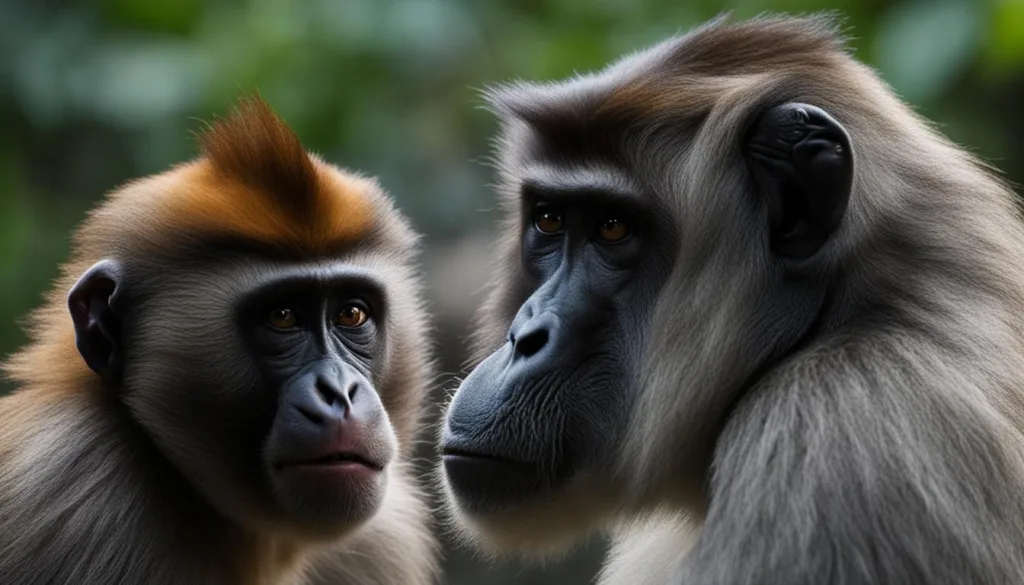From Primate to Person: The Evolutionary Journey of Emotions
Imagine, for a moment, our ancient past enveloped in the untamed beauty of a world that buzzed with the purest forms of survival and instinct. It was there, amidst the dense foliage and primal calls of our early primate relatives, that the seeds of emotional development were planted. Today, as we navigate an ever-changing social landscape, the fruits of those ancestral labors persist within us; a testament to our shared evolutionary journey. It’s a journey that interlaces the progression of primate behavior with our own deep-rooted need to feel and connect. And as we delve into this exploration, we invite you to consider not just the evolution of emotions that we’ve inherited, but also how they continue to shape our complex tapestry of human psychology.
We hold within us an uncanny resemblance to these distant relatives, a mirror reflecting the emotional contours that have been refined by the sands of time. The notion that we are not so distant from the ancient primates who once roamed the earth is not only intriguing—it’s deeply humbling.
Key Takeaways
- Understanding the interrelation between primate behavior and human emotions is essential to the study of emotional development.
- Darwin’s insights into the evolutionary continuity of emotional expressions deeply resonate with our human psychology.
- Groundbreaking research in behavioral and brain science further elucidates the evolution of emotional processing mechanisms.
- The Facial Action Coding System (FACS) serves as a bridge connecting human expressions with those seen in our primate cousins.
- Our shared history with primates offers invaluable lessons on the intricate development of emotional behaviors.
- Continued studies in emotion reveal not only our ancestry but also guide our understanding of social interactions and cognition.
- The exploration of the evolution of emotions helps us unravel the complexity of human connections.
Tracing the Roots: The Beginnings of Emotional Development
As we delve into the mysteries of ancestral emotions and the fabric of our being, it becomes evident that the tapestry of human emotion is woven with strands of our evolutionary past. Our journey into understanding the underpinnings of emotional development leads us to draw parallels between primate behavior and human psychology, guided by the principles of affective science and evolutionary psychology.
Before we explore the intricate networks that have given rise to our capacity for complex emotions and social bonding, let’s consider the structural aspects that set the stage for these developments. The behavioral science community has traced back the cognitive abilities required for emotional intelligence to certain key changes in primate brain structures.
Anatomical Evidence from Primate Brain Studies
We see in our primate cousins, the evolutionarily sculpted landscapes of the brain, a reflection of our own cerebral composition. Markers of comparative neurogenesis are evident in the granular prefrontal cortex, a domain critical for the processing and regulation of emotions. This shared anatomy across primate species grants us a glimpse into our evolutionary psychology, where we find common ground in the developmental trajectory of our emotional heritage.
Social Bonding and the Rise of Complex Emotions
The rise of complex emotions cannot be discussed without acknowledging their role in creating and maintaining social bonds. The fibers of empathy and altruism, which we observe in many primates, are not just threads of passing interactions but are essential for the fabric of group cohesion and survival. Such emotions are the very mechanisms through which our brains—be it human or primate—navigate, understand, and predict the behaviors of others, illustrating the paramount importance of social cognition and emotional regulation in our collective evolution.
Comparative Analysis of Primate Behavior and Human Psychology
Comparative studies sharpen our insights into the lineage of our emotional behaviors. When examining the tapestry of primate social behaviors—be it facial expressions, vocalizations, or intricate displays of body language—we uncover patterns and threads that mirror human emotional manifestations. Tools like the Facial Action Coding System (FACS) offer a well-defined structure to analyze these emotional expressions, providing a clearer understanding of our shared ancestral roots and the evolutionary forces that have shaped our sophisticated realm of emotional cognition and response.
In our pursuit to decode the richness of human emotion, we must continue to stitch together knowledge from various fields, like a quilt that lays bare the essence of our psychological and emotional lineage—one that is not only complex but also wonderfully interconnected across time and species.
Unlocking Emotions: Key Adaptations in Human Ancestors
Delving into our past, we uncover the remarkable transformations that have shaped human emotional development. The prefrontal cortex expansion stands as a monumental shift, deeply influencing the way we process and express emotions. It’s a story of evolution, from gene expression to the emerging complexities of emotional intelligence, all integral to understanding our social and personal existence.
The Power of the Prefrontal Cortex: Expansion and Cognition
At the forefront of our cognitive evolution, the prefrontal cortex is a testament to the advancements that underpin our intricate emotional tapestry. Through its remarkable expansion, it has granted us the capacity for complex thought and regulation—cornerstones of emotional development that pave the way for more nuanced social interactions and heightened emotional intelligence in humans.
Influence of Gene Expression: FOXP2 and NOTCH2NL in Emotional Evolution
Peering into our genetic blueprint, we find the marks of evolution—specifically in the roles of FOXP2 and NOTCH2NL genes. These culprits of change have tailored our brain’s fabric, augmenting cognitive abilities and enabling the expansion of emotional intelligence. Their imprint on gene expression is a signature of evolution, decisively contributing to our developmental narrative.
Comparative Neurogenesis and Emotional Intelligence
Embracing a comparative perspective, we observe that neurogenesis across different species offers invaluable insights into our own emotional evolution. The genetic nuances that foster cerebral development mirror the growth of human emotional intelligence, painting a picture of how social bonding and personal awareness have evolved in tandem with the complexity of our neural networks.
| Feature | Evolutionary Significance | Impact on Emotional Intelligence |
|---|---|---|
| Prefrontal Cortex Expansion | Supports advanced cognitive functions necessary for complex social environments | Enhances emotional regulation, decision-making, and higher-order thinking |
| Gene Expression (FOXP2, NOTCH2NL) | Contributes to nuanced brain development and cognitive capabilities | Facilitates the emergence of sophisticated emotional responses and social behaviors |
| Comparative Neurogenesis | Reflects the adaptive nature of neural development across species | Aligns with the advancement of emotional intelligence as a cornerstone of human evolution |
The Evolution of Emotions in the Primate Lineage
Understanding the progression of ancestral emotions reveals the intricate tapestry of our psychic past. As researchers in affective science, we have discerned notable patterns in primate behavior that underline the fluidity and complexity of mood regulation. This journey from simple survival instincts to rich emotional landscapes speaks volumes about our biological legacy.

Our investigations into the hippocampal complex and default network highlight a striking capacity for nuanced emotions such as nostalgia and anticipation. These not only reflect individual moods but underpin broader social phenomena, allowing primates—humans included—to thrive in diverse habitats and complex social structures.
| Emotional Capacity | Early Ancestors | Modern Humans |
|---|---|---|
| Survival instincts | Basic expressions correlated with immediate needs | Refined instincts with future-oriented strategies |
| Social interactions | Elementary signals for mating and territorial defense | Complex language and non-verbal cues for a range of social scenarios |
| Mood regulation | Rudimentary self-regulation in response to environmental changes | Advanced strategies involving cognitive reappraisal and emotional intelligence |
As we delve deeper into our evolutionary history, it’s evident that the chronology of primate emotions dovetails with the shifting landscapes of our habitats and societies. Join us as we continue to unravel this captivating evolutionary narrative, enriched by our shared biological and emotional heritage.
Facial Expressions and Emotional Communication Across Species
Understanding the intricate dance of facial expressions within the animal kingdom offers us a glimpse into the rich tapestry of emotional communication. Through the lens of evolutionary psychology, we examine the silent yet profound language of facial gestures that bridge the gap between our primate cousins and us. The shared lineage of primate behavior unfolds on the stages of our faces, where each grimace, smile, or frown echoes an ancestral past.

Facial expressions serve as non-verbal cues that can convey a multitude of emotions without a whisper. It’s through these visual signals that primates, including humans, have navigated the social complexities of their environments. This silent orchestration of muscle movements has been pivotal to survival, influencing mating choices, social hierarchy, and group dynamics.
But how do these expressions differ among species, and what can they tell us about the emotional lives of our distant relatives? To answer this, scientists have utilized the Facial Action Coding System—a tool that deciphers the anatomy of emotion through facial movements.
| Facial Expression | Human | Non-Human Primate |
|---|---|---|
| Joy | Smiling with raised cheeks and crow’s feet | Open-mouthed play face, indicative of playfulness or non-aggression |
| Anger | Furrowed brow, narrowed eyes, and a tight-lipped frown | Bared teeth and tense mouth, signaling a threat or dominance |
| Sadness | Drooping eyelids, downturned mouth, and slight frown | Lowered head and averted gaze, less pronounced in non-human expressions |
| Surprise | Raised eyebrows, wide eyes, and open mouth | Rapidly opening eyes, often during play or exploration |
Exploring these emotional expressions reveals more than just individual feelings; it showcases the complex network of social signals that have been fundamental in primate societies for millennia. The common thread tying these expressions together is their evolutionary utility, a testament to the adaptive power of non-verbal communication.
And so, we continue to decode the silent dialogues of our primate counterparts. Each furrow of the brow and twinkle of the eye whispers ancestral secrets, painting a fuller picture of our place within the grand evolutionary mosaic.
Sharing Feelings: Empathy and Emotional Complexity in Human Evolution
As we traverse the rich landscape of human evolution, we encounter the profound influence of empathy on our emotional development. The fascinating discovery of mirror neurons has been fundamental in deciphering the neurological underpinnings of our ability to share the feelings of others and has played a pivotal role in the complex tapestry of social bonding.
Developing Empathy: The Role of Mirror Neurons
In our quest to understand how empathy has evolved, mirror neurons emerge as the stars of behavioral science and evolutionary psychology. These neurological gems reflect the actions and emotions witnessed in others, essentially allowing us to ‘mirror’ the internal state of our peers. This remarkable system serves as the bedrock for the warm social connectivity that typifies the human species.
Empathic Accuracy and Social Connectivity in Humans Versus Primates
While both humans and our primate relatives exhibit forms of empathy, it’s the sophistication of empathic accuracy — our ability to finely tune into the emotions of others — that distinguishes our species. This remarkable quality facilitates the richly woven social networks that are the hallmark of human societies.
The Emotional Impact of Language and Self-Reflection in Homo Sapiens
The advent of language and the propensity for self-reflection have profoundly sculpted the emotional intelligence of Homo sapiens. Through these powerful tools, we have harnessed the ability to convey and ponder our most intricate feelings, fostering unparalleled levels of understanding and cooperation within our social milieu.
Let us delve deeper into this concept through a table that contrasts the empathic capabilities of Homo sapiens with those of our primate cousins:
| Empathic Ability | Homo Sapiens | Primates |
|---|---|---|
| Mirror Neuron Activity | Highly responsive to observed actions and emotions | Present but less extensive |
| Empathic Accuracy | Advanced discernment of complex emotional states | Basic understanding linked to tactile actions |
| Social Connectivity | Extensive social networks reliant on emotional understanding | Social bonds, primarily within direct community |
| Influence of Language | Facilitates complex emotional exchanges and self-analysis | Limited to immediate needs and social signals |
| Self-Reflection | Ability to introspect and contextualize emotions in a broader sense | Absent or primal self-awareness relating to physical state |
In conclusion, our journey through the corridors of human psychology brings us face to face with the immense power of empathy. The intricate entanglement of emotional development and empathic mechanisms has charted a unique course for our species, culminating in a level of social harmony that is distinctively human.
From Affective Science to Behavioral Science: The Intersection of Emotions and Action
As we delve into the realms of affective science and behavioral science, we’re fascinated by how deeply our emotions are woven into the fabric of our actions. It’s not just about feeling—emotions guide our decision-making processes in ways traditional science is just beginning to understand. Our journey through the exploration of emotional regulation illuminates how we have harnessed our emotional responses to better navigate our social world.
In affective science, emotional intelligence and emotional regulation are pivotal. Emotional intelligence lets us discern and understand our own and others’ emotions; emotional regulation enables us to modulate these emotions. This skill is critical, not just interpersonally but intrapersonally—it’s what allows us to remain composed during a crisis or stay motivated despite discouragement.
Behavioral science complements this by exploring how these emotionally intelligent responses manifest in our behaviors. Imagine a professional navigating a high-stakes negotiation, or a teacher managing a diverse classroom—their success often hinges on their ability to both read emotional cues and modulate their own emotional reactions in real-time.
What’s fascinating is how this intricate dance of emotion and action shapes societies and cultures. Here’s an interesting way to see it:
- Our ancestors developed emotional responses as survival mechanisms.
- Over time, these responses became more nuanced, enhancing social cohesion and communication.
- Today, we see a complex interplay where societal norms and individual behaviors are in a constant feedback loop, moderated by our ability to understand and control our emotional responses.
This seamless blend between affective and behavioral sciences offers us a richer perspective on human behavior. It speaks to our evolutionary past and underscores the sophistication of our emotional toolkit, which doesn’t just react to the world, but actively shapes it.
Through the lens of both affective and behavioral sciences, we come to appreciate the symphony of human experience—where every thought, feeling, and action is interconnected, playing a vital role in the narrative of our species.
In essence, this journey isn’t just about theorizing emotions; it’s about recognizing their power in driving actions that make up the human experience. As we continue to research and understand these concepts, we not only uncover more about our evolutionary past but also gain insights that propel us toward a future of greater emotional savvy and societal well-being.
Conclusion
In our journey to understand the tapestry of the human psyche, we’ve delved into the depths of evolutionary psychology and ancestry, uncovering the roots from where our emotions first bloomed. By tracing the lineage of these primal sensations, we perceive that the spectrum of our emotions, from joy to sorrow, is not merely a human experience but a shared heritage with our primate cousins. It is through the insight of ancestral emotions that we’ve come to appreciate the complexity of human psychology and the pivotal role emotions play in shaping our interactions with the world and each other.
Synthesis of Evolutionary Psychology and Ancestral Emotions
Our exploration brings us to a profound synthesis of evolutionary psychology with the raw, unadulterated emotions of our ancestors, providing clarity on why we feel the way we do. Research on primate behavior, genetic contributions to brain development, and the underpinnings of emotional intelligence reveals the evolutionary narrative we’re all part of. This understanding affirms our belief that mood regulation, social bonding, and the rich diversity of human emotions are firmly rooted in our biology, intricately woven through the fabric of time from the earliest of our lineage.
Toward a Holistic Understanding of Mood Regulation and Social Bonding
In striving for a holistic comprehension of ourselves, we acknowledge the interconnection between mood regulation and social bonding as they contribute to our survival as a social species. The dynamic equilibrium between neurological structures and genetic variables, shaped by evolutionary pressures, has fostered the development of the complex mechanisms that assist us in navigating the social landscape. It’s this intricate web of connections that carves out our place within the realm of emotional development and fuels our ongoing quest for knowledge.
The Future of Research in Emotional Development and Evolution
As we stand on the cusp of new discoveries, the future of research in the field of emotional evolution is bright with potential. With each comparative study, genetic analysis, and cultural evaluation, we edge closer to deciphering the subtleties that define our emotional world. It is through such rigorous research that we aspire not just to enrich our understanding of human history, but to apply this knowledge toward fostering emotional well-being and social unity in today’s society. Indeed, the quest to unravel the secrets of our emotional evolution is perpetual, shaping not just the narrative of our past, but the promise of our future.
FAQ
How have emotions evolved from primates to modern humans?
Emotions have evolved significantly from our primate ancestors to modern humans. This evolutionary journey has involved the development of complex emotions tied to an expanded prefrontal cortex, improved emotional communication through facial expressions, and more sophisticated social bonding and empathic abilities.
What anatomical evidence from primate brain studies supports the evolution of emotions?
Primate brain studies show that the granular prefrontal cortex, crucial for emotional processing, is present across various primate species. The expansion of this and other brain regions in humans supports the cognitive demands of our complex social interactions and emotional behaviors.
Social bonds are integral to the evolution of complex emotions. Emotional expressions that facilitate empathy, group cohesion, and altruism have been critical for forming social connections and have driven the evolution of brain regions essential for social cognition and emotional regulation.
In what ways do human emotional expressions differ from those of non-human primates?
While there are many similarities in emotional expressions across primate species, human emotional behaviors are often more complex and tied to internal states. Non-human primates use facial behaviors for dynamic social functions, whereas humans use them to convey a broader range of emotions.
What role does the prefrontal cortex play in human emotion?
The prefrontal cortex plays a central role in human emotion by supporting cognitive flexibility, complex decision-making, and advanced emotional understanding. Its expansion is associated with the increased cognitive complexity of human social environments and emotional responses.
How do gene expression and neurogenesis contribute to emotional evolution?
Gene expression and neurogenesis play significant roles in emotional evolution. Genes such as FOXP2 and NOTCH2NL and ARHGAP11B influence the development of the brain’s regions involved in emotional processing, contributing to our advanced cognitive abilities and complex social behaviors.
How do empathy and emotional complexity relate to human evolution?
Empathy and emotional complexity have been pivotal in human evolution. The development of mirror neurons and our advanced empathic accuracy has allowed us to form intricate social networks. These complex emotions have been integral to the development of human societies and their nuanced social structures.
How does the study of affective science and behavioral science intersect with emotions?
Affective science and behavioral science intersect with emotions through the study of emotional regulation and its impact on decision-making and behavior. Emotional intelligence, which is deeply rooted in these sciences, is crucial for human interactions and cultural advancements.
What insights can evolutionary psychology provide about our ancestral emotions?
Evolutionary psychology offers insights into our ancestral emotions by integrating data from primate behavior, neuroscientific studies, gene research, and more. It helps explain our emotional heritage and suggests that our emotional spectrum has deep biological origins and is tightly linked with our shared evolutionary past with other primates.
Understanding mood regulation and social bonding is vital because these elements are fundamental to how we adapt to social situations and how we’ve evolved as a species. These factors not only contribute to individual well-being but also to the stability and success of social groups throughout human history.
What directions might future research in emotional development and evolution take?
Future research in emotional development and evolution is likely to uncover more about the genetic underpinnings of emotions, how culture and environmental factors influence emotional expression, and the ways emotions can enhance our well-being and social harmony. It continues to be an area rich with potential for new discoveries that could profoundly affect our understanding of human nature.






